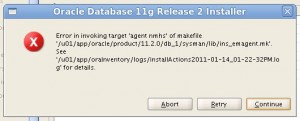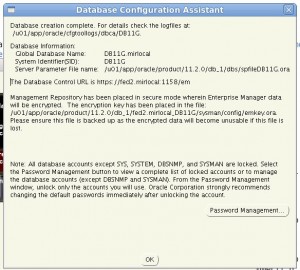Tu można znaleźć wszystko czego dusza zapragnie:
http://www.oracle-base.com/articles/11g/OracleDB11gR2InstallationOnFedora14.php
Fajna strona o parametrach SHMALL, SHMMAX ..
http://www.idevelopment.info/data/Oracle/DBA_tips/Linux/LINUX_8.shtml
Fajna strona o ustawianiu parametrów TCP w Linuksie:
http://www.speedguide.net/articles/linux-tweaking-121
Strona o instalacji OHS:
http://apex-at-work.blogspot.com/2010/11/oracle-http-server-ohs-part-of-oracle.html
aio-nr & aio-max-nr:
aio-nr is the running total of the number of events specified on the
io_setup system call for all currently active aio contexts. If aio-nr
reaches aio-max-nr then io_setup will fail with EAGAIN. Note that
raising aio-max-nr does not result in the pre-allocation or re-sizing
of any kernel data structures.
you can increase the maximum number of open files by setting a new value
in kernel variable /proc/sys/fs/file-max
Setting SHMALL Parameter This parameter sets the total amount of shared memory pages that can be used system wide. Hence, SHMALL should always be at least ceil(shmmax/PAGE_SIZE). The default size for SHMALL in RHEL 3/4 and 2.1 is 2097152 which is also Oracle's recommended minimum setting for 9i and 10g on x86 and x86-64 platforms. In most cases this setting should be sufficient since it means that the total amount of shared memory available on the system is 2097152*4096 bytes (shmall*PAGE_SIZE) which is 8 GB. PAGE_SIZE is usually 4096 bytes unless you use Big Pages or Huge Pages which supports the configuration of larger memory pages.First off, editing sysctl.conf doesn't change the value until you either reboot, or execute: sysctl -p To have it reload the values. You mention this is a 32-bit Linux. That puts constraints on how large you can set SHMMAX to and how big the Oracle SGA can be. See Installing Oracle9i on FC2 for more information about the limits you'll run into here. The largest generally useful setting is this: kernel.shmmax=2147483648 And since the one you tried is >4GB that's why it failed altogether. Many people seem to use some guide or Oracle's suggestions for a setting here as a magic number without actually considering whether the shared memory values really make sense for their system or not. I wrote the following little script to generate the settings for me on Linux. As written, it limits the shared memory block to 50% of total RAM, which might be light for your Oracle use; easy to adjust it to a higher percentage. I hate seeing people set this value to higher than the amount of RAM in their server.#!/bin/bash mem_bytes=`awk '/MemTotal:/ { printf "%0.f",$2 * 1024}' /proc/meminfo` mem_max=`expr $mem_bytes / 2` page_size=`getconf PAGE_SIZE` shmall=`expr $mem_bytes / $page_size` echo \# Maximum shared segment size in bytes echo kernel.shmmax = $mem_max echo \# Maximum number of shared memory segments in pages echo kernel.shmall = $shmallThe output from this can get written right to the end of the sysctl.conf, run "sysctl -p", and you're off with a reasonable yet safe setting.shmmni specifies the maximum number of shared memory segments allowed to exist simultaneously, system-wide. Setting shmmni to an arbitrarily large number wastes memory and can degrade system performance. Setting the value too high on systems with small memory configuration may consume enough memory space that the system cannot boot. Select a value that is as close to actual system requirements as possible for optimum memory usage. A value not exceeding 1024 is recommended unless system requirements dictate otherwise. Semaphores can best be described as counters which are used to provide synchronization between processes or between threads within a process for shared resources like shared memories. System V semaphores support semaphore sets where each one is a counting semaphore. So when an application requests semaphores, the kernel releases them in “sets”. The number of semaphores per set can be defined through the kernel parameter SEMMSL/proc/sys/net/core/rmem_max - Maximum TCP Receive Window /proc/sys/net/core/wmem_max - Maximum TCP Send Window /proc/sys/net/ipv4/tcp_rmem - memory reserved for TCP rcv buffers (reserved memory per connection default) /proc/sys/net/ipv4/tcp_wmem - memory reserved for TCP snd buffers (reserved memory per connection default) /etc/selinux/config ustawić selinux=disabled
The xhost program is used to add and delete host names or user names to the list allowed to make connections
to the X server.
Po wykonaniu instalki wg. instrukcji instalator dalej marudzi:Gdy się da ignoruj, to wywala się na linkowaniu binariów:
aby pozbyć się błędu ins_emagent.mk należy:
This error is due to a change in the GCC linker in Fedora 13. The announcement is here. The fix is to edit $ORACLE_HOME/sysman/lib/ins_emagent.mk, search for the line $(MK_EMAGENT_NMECTL) and replace the line with $(MK_EMAGENT_NMECTL) -lnnz11 as shown above. Informacja pochodzi ze strony: http://blog.fpmurphy.com/2010/08/installing-oracle-11g-release-2-on-fedora-13.html#ixzz1BIWbQ3ps
Logowanie do EM: OK
emctl stop dbconsole emctl start dbconsole







